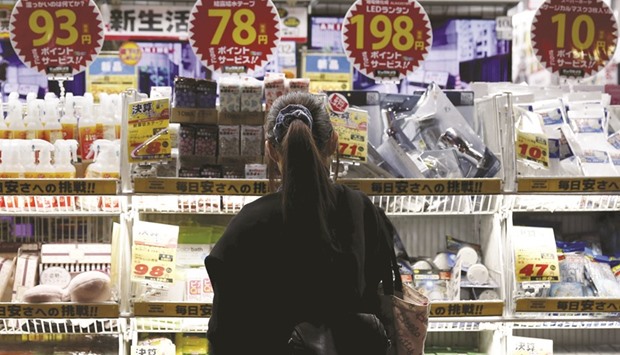Japan’s core consumer prices marked their eighth straight month of annual declines in October, illustrating the sheer scale of the central bank’s struggle to beat deflation and stagnant growth with diminishing policy options.
The data will keep policymakers under pressure to do more to stimulate the economy, with fiscal spending likely the more preferred option as three years of aggressive easing by the Bank of Japan failed to accelerate inflation to its 2% target.
With downward pressure from energy price declines easing and the yen’s recent falls seen pushing up import costs, however, some analysts expect consumer prices to rebound early next year.
The nationwide core consumer price index, which includes oil products but excludes volatile fresh food costs, fell 0.4% in October from a year earlier after a 0.5% drop in September, matching a median market forecast, government data showed yesterday.
While falling gasoline and electricity prices continued to drag down inflation, nearly 60% of items making up the index saw prices rise, the data showed. “We still think that underlying inflation will fall a touch further in coming months in response to the sharp falls in import prices in previous months,” said Marcel Thieliant, senior Japan economist at Capital Economics. “However, the output gap (the difference between the economy’s potential GDP and actual GDP) has narrowed and we expect it to rise further in coming months, so price pressures should strengthen again before long.
What’s more, the yen has weakened sharply against the dollar recently.
We think that underlying inflation will reach a bottom in the first quarter of next year.” A separate index compiled by the BoJ, which strips out the effect of energy and fresh food costs, showed inflation hit 0.3% in October, slightly up from a three-year low of 0.2% marked in September.
Japan’s economy expanded for a third straight quarter in the July-September quarter as exports recovered, but weak domestic activity cast doubt on hopes for a sustainable recovery.
Data due out next week will likely show an uninspiring picture of the recovery with analysts polled by Reuters predicting roughly flat growth in factory output and a decline in retail sales in October.
The BoJ has acknowledged that it will take time for inflation to accelerate to its target, modifying its policy framework in September to one better suited to a protracted battle against deflation.
It kept policy steady at a subsequent meeting in October despite pushing back the timeframe for hitting its price target.
“There are signs inflation is picking up, so the BoJ is seen maintaining its current policy for the time being,” said Takeshi Minami, chief economist at Norinchukin Research Institute. Japanese policymakers are starting to see fiscal stimulus as the most likely next step to spark growth, given uncertainty over US president-elect Donald Trump’s trade and currency
policies.
But a budget outline showed Prime Minister Shinzo Abe plans only a modest boost to government spending next year, showing that he is taking a different policy direction than one expected from Trump, who has pledged fiscal stimulus. The yen’s recent declines offer some relief for Japan’s export-reliant economy, as big automakers and manufacturers have seen profits hit by the currency’s rise earlier this year.
The dollar rose to an eight-month high against the yen yesterday, extending its rally since Trump’s election to US President stoked expectations of higher US economic growth and inflation.

A woman looks at items outside a store at a shopping district in Tokyo. Japan’s core consumer prices marked their eighth straight month of annual declines in October, illustrating the sheer scale of the central bank’s struggle to beat deflation and stagnant growth with diminishing policy options.
